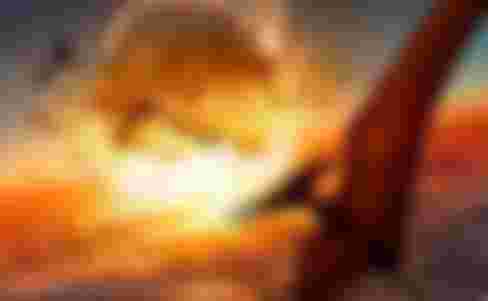

Five tragic events in history
Although the history written by human beings is only a few thousand years old, the history of the world is 4.6 billion years old. How many things have happened on this only habitable planet we know in this long period of time. Millions of species of animals have migrated. If so, where are they now?
99 percent of them are either lost today or not in the museum today and still under the ground. Exactly five times in history, the world's biodiversity has been destroyed. Lost forever. This is sometimes due to large volcanic eruptions, sometimes large geographical changes, sometimes thunderstorms or large meteorites.
These events are called mass extinctions or mass extinctions. It is also called 5 major extinctions or 5 mass extinctions in English. Let's not forget the five tragic events of history.
1. Ordovician Silurian extinction or mass extinction
The first mass extinction in the history of the world occurred 440 million years ago. This mass extinction destroyed 75 percent of the world's animals at that time. Even at that time, the living world could not fully develop on earth. By the time of the Ordovician period, marine and terrestrial fauna had begun to flourish. At that time the Appalachian Mountains were being born in America. These mountains expose some silicate rocks at birth. Which absorbs CO2 from the air. Lack of CO2 stops a kind of global warming. The earth cools and freezes. The final change in climate comes overnight, exceeding the tolerance level of the still evolving fauna. Ordovician mass extinction occurs in two stages. In the first stage, a long ice age begins on the earth, when the weather of the whole earth becomes extremely cold, most of the ice in the water body goes down to the water level. During this time all terrestrial animals die, and countless marine species die. But the end of the ice age was by no means a relief for the remaining aquatic survivors. The end of the ice age happened so quickly that the animals that survived the severe cold for a long time did not get to adaptation. Even as the sea level rose rapidly as the ice melted, the amount of oxygen in the water did not return to normal. As well as this time a hypernova bursts 6,000 light years away. As a result, most of the fauna of the rest of the sea also became extinct. Only a few marine autotrophs are able to survive.
2. Devonian mass extinction or mass extinction
The Devonian extinction or mass extinction occurred approximately 365 million years after the Ordovician extinction or mass extinction. From the ruins of the Ordovician extinction or mass extinction, the fauna still remained in the early stages of evolution. In the meantime, in the event of the Devonian extinction or mass extinction, 80 percent of the aquatic and terrestrial animals will be wiped out from the face of the earth. Although scientists have not been able to determine the exact cause of the Devonian mass extinction, this mass extinction has been accomplished in two stages. In the first stage, the marine environment suddenly becomes hostile to marine animals, especially marine plants. Within a short range, therefore, a large proportion of marine flora adapted to land. When the amount of oxygen produced in the sea decreases, most of the marine animals die due to lack of oxygen. Meanwhile, in a short period of time, when the number of plants on the ground increases much faster than the number of animals, the amount of CO2 in the Earth's atmosphere suddenly decreases rapidly. And as soon as the reduction in greenhouse gases occurs, the earth's temperature drops faster, the weather becomes more extreme, and most terrestrial animals fall to their deaths. The cause of the mass extinction of the second stage of the Devonian stage is still a mystery. Most likely, the eruption was caused by a large volcanic eruption or meteor shower.
3. Permian Triassic extinction or mass extinction
The Paleozoic era is probably the worst era in the history of the world. The catastrophe that occurred during this time is known as the Permian Triassic Extinction or Mass Extinction. Which is known as the biggest extinction in the history of the world. Approximately 250 million years ago, this last chapter of the Paleozoic era occurred in the Permian stage. About 97 percent of the animals that existed at the time of the extinction of the Permian mass extinction! Scientists have not been able to pinpoint the cause. However, it is thought that most likely the cause of death was a volcanic eruption and a large meteor shower. However, according to most researchers, the catastrophe was caused by both volcanoes and meteorites. The amount of methane in the air increased exponentially, the Earth's climate became uninhabitable, the temperature rose more than ever. Then the Mesozoic era came with the remaining 4 percent.
4. Triassic-Jurassic extinction or mass extinction
The Triassic extinction, or mass extinction, began about 200 million years ago when the Mesozoic epoch reached its final stage. During the last 16 million years of the Triassic, various small extinctions have occurred, during which time about 50 percent of the species that exist have disappeared from the face of the earth. And the only reason for this mass extinction is the eruption of a huge volcano. By the end of the Triassic, there have been so many volcanic eruptions on Earth that a large part of the landmass has been flooded by basalt or volcanic eruptions. That is why many terrestrial animals are destroyed. Massive volcanic eruptions increase the amount of methane in the air, causing large-scale changes in climate. Overall the situation is so unfavorable that a large number of animals cease to exist.
5. Cretaceous-Tertiary extinction or mass extinction
The last mass extinction in the history of the world occurred 65 million years ago. This extinction draws a dividing line between the two long eras. This mass extinction occurs between the last phase of the Mesozoic period, the Cretaceous stage, and the first chapter of the Cenozoic period, the Tertiary stage, so it is called the Cretaceous-Tertiary extinction or mass extinction. Eighty-five percent of the species in the animal kingdom, including the well-known dinosaur, died in the extinction. The cause of this mass extinction is also clearer and more precise than the others. This extinction begins with a massive meteor shower or the fall of an asteroid. The massive meteors or asteroids that have turned into fiery fires due to the friction of the Earth's atmosphere have destroyed the dinosaurs. After meteorite debris spreads into the atmosphere, absolutely to the stratosphere. Sunlight is very low. The world was then a dense black cloud world. Large trees die due to lack of photosynthesis due to very low light. Most animals die at the end of not eating. With the exception of some crocodiles and birds, almost all types of dinosaurs became extinct.
Reading so much may make you think, 'We've survived.' I give them a spoiler.

